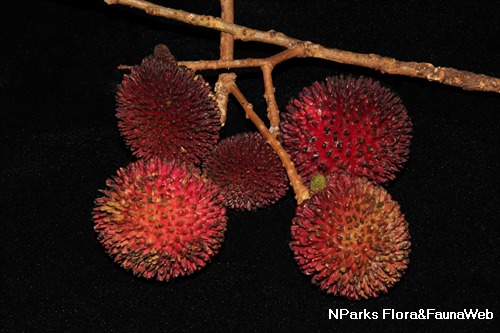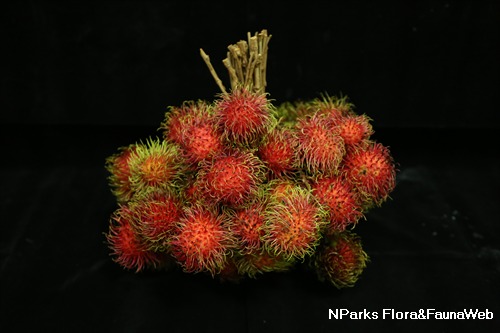_lowres.jpg)
Back
Nephelium cuspidatum
| Family Name: | Sapindaceae |
| Common Name: | Lotong |
Nephelium cuspidatum, also known as Lotong, is a tree, up to 40 m tall. Found in lowland primary and secondary rainforest, it has long pendulous white inflorescence. The fruit ripens red, and is often densely covered with narrow thread-like appendages. The seed is surrounded with an edible white fleshy sarcostesta.
Name
Classifications and Characteristics
| Plant Division | Angiosperms (Flowering Seed Plants) |
|---|---|
| Plant Growth Form | Tree |
| Lifespan (in Singapore) | Perennial |
| Mode of Nutrition | Autotrophic |
| Plant Shape | Irregular |
| Maximum Height | 40 m |
| Tree or Palm – Trunk Diameter | 0.8 m |
Biogeography
| Native Distribution | Myanmar, Thailand, Cambodia, Vietnam, and Malesia. |
|---|---|
| Native Habitat | Terrestrial |
| Preferred Climate Zone | Tropical |
Description and Ethnobotany
| Growth Form | It is a tree, up to 40 m tall, and sometimes with small buttresses. The trunk can reach up to 0.8 m wide. Twigs are usually densely hairy and rarely glabrous. |
|---|---|
| Foliage | Leaves are compound and arranged alternately. Each leaf comprises of (1-) 2 – 9 (-13) leaflets. Leaflets are leathery and narrowly elliptic shaped (6 – 25 cm long and 1.75 – 12.5 cm wide). The base of the leaflet is narrow to broadly rounded while leaflet tip is pointed, up to 2.5 cm long or sometimes obtuse. Petiole is hairy and 2.5 – 21 cm long. Domatia is absent. |
| Flowers | Inflorescence occur as long pendulous spikes on the axillary and/or pseudoterminal position, as well as on the trunk (cauliflorous). The inflorescence is 10 – 25 cm long and comprises of many small white flowers. |
| Fruit | The fruit is ellipsoid to globular (2 – 4 cm long and 2 – 3 cm wide), red coloured and often densely covered with narrow thread-like or strap-shaped appendages. The appendages may sometimes be straight or curved. Fruit may sometimes be glabrous or slightly hairy at the tip of the appendages too. |
| Habitat | It is found in lowland primary and secondary rainforest, usually on ridges and slopes. |
| Associated Fauna | Flowers are pollinated by insects. |
| Taxonomy | Presently, six varieties of Nephium cuspidatum are recognized. |
| Cultivation | It can be propagated by seed. |
| Etymology | Genus epithet 'Nephelium', in Greek, means cloud. Latin cuspidatus refers to the gradual tapering of the leaflet apex. |
| Ethnobotanical Uses | Edible Plant Parts : Edible Fruits Food (Fruit or Vegetable): The seed is surrounded with an edible white fleshy sarcostesta which is said to have a sourish taste. It is cultivated as a fruit tree in South east Asia. Timber & Products: The wood is low quality and is sometimes used for construction. |
Landscaping Features
| Landscape Uses | Parks & Gardens |
|---|
Fauna, Pollination and Dispersal
| Pollination Method(s) | Biotic (Fauna) |
|---|---|
| Seed or Spore Dispersal | Biotic (Fauna) |
Plant Care and Propagation
| Light Preference | Full Sun |
|---|---|
| Water Preference | Moderate Water |
| Plant Growth Rate | Moderate |
| Rootzone Tolerance | Well-Drained Soils, Fertile Loamy Soils |
Foliar
| Foliage Retention | Evergreen |
|---|---|
| Mature Foliage Colour(s) | Green |
| Mature Foliage Texture(s) | Leathery |
| Foliar Type | Compound |
| Foliar Arrangement Along Stem | Alternate |
| Foliar Attachment to Stem | Petiolate |
| Foliar Venation | Pinnate / Net, Reticulate |
| Foliar Margin | Entire |
| Foliar Apex - Tip | Obtuse, Acuminate |
| Foliar Base | Cuneate, Rounded / Obtuse |
Non - Foliar and Storage
| Trunk Type (Non Palm) | Woody |
|---|---|
| Root Type | Underground |
Floral (Angiosperm)
| Flower & Plant Sexuality | Unisexual Flowers , Dioecious |
| Flower Colour(s) | Cream / Off-White, White |
|---|
| Flower Grouping | Cluster / Inflorescence |
| Flower Location | Cauliflorous, Axillary, Terminal |
| Flower Symmetry | Radial |
| Individual Flower Shape | Saucer-shaped |
| Flower Size - Remarks | Flowers are small and inconspicuous. |
| Inflorescence Type | Spike, Raceme |
| Flowering Period | Once Yearly |
| Flowering Habit | Polycarpic |
Fruit, Seed and Spore
| Mature Fruit Texture(s) | Leathery |
|---|---|
| Fruit Classification | Simple Fruit |
| Fruit Type | Fleshy Fruit , Drupe |
| Seed Quantity Per Fruit | Few (1-5) |
References
| References | Adema, F., Leenhouts, P.W. & van Welzen, P.C. (1994). Sapindaceae. In: Kalkman, C., Stevens, P.F., Kirkup, D.W., de Wilde, W.J.J.O. & Nooteboom, H.P. (eds) Flora Malesiana, ser.1, vol. 11, part. 3, pp. 419–768. Leiden: Rijksherbarium. Keng, H. (1990). The Concise Flora of Singapore: Gymnosperms and Dicotyledons. Singapore: Singapore University Press. |
|---|
Image Repository
Others
| Master ID | 30174 |
|---|---|
| Species ID | 4483 |
| Flora Disclaimer | The information in this website has been compiled from reliable sources, such as reference works on medicinal plants. It is not a substitute for medical advice or treatment and NParks does not purport to provide any medical advice. Readers should always consult his/her physician before using or consuming a plant for medicinal purposes. |

_lowres.jpg)
_lowres.jpg)
_lowres.jpg)



_lowres.jpg)